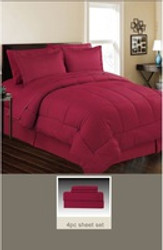How to Clean Different Types of Linen
3rd Mar 2016
Cleaning household linens is determined by the type of fabric in question. For linens made from natural fibers such as cotton or linen, the fabric should ideally be rinsed as soon as possible in cold water to prevent the stain from becoming permanent. However, stains from red wine, red or purple berries or fruit are an exception and will need to be washed in boiling water.
Washing Instructions for Different Types of Linen
Generally, regular washing of different types of linens should be done in hot water for hygienic reasons and to destroy bacteria left on the linens from frequent use. More specifically, different linen types should be treated in the following ways:
Cleaning Silk Linens
Silk is a very strong fabric that can last for many years if cared for properly. When washing silk linens, consider using a gentle detergent and one that does not include bleach. This is because bleach can be very damaging to silk fabric types and can cause them to turn yellow. It is recommended to use cold water when washing silk linens. Silk linens that become stained need to be washed as soon as possible for if left untreated, the stain will become much more difficult to remove. Spot cleaners designed for silk work best, but if unavailable then try cleaning the stain with cold water and detergent. For tougher stains bring silk linen to a dry cleaner.
At the same time never dry silk in the dryer with any heat setting. Instead, the same can be placed in a tumble dryer for silk setting, or use a non-heat tumble dry option. Otherwise it is recommended to hang dry silk linens indoors in a cool location as sunlight can also cause fading over time.
Cleaning Cotton Linens
Cotton is a preferred fabric by many for household linens given its comfort and durability. For properly cleaning cotton linens, it is important not to put all linens in the wash together but to clean them separately. For instance do not launder sheets with towels or other clothing. Not only will this give the sheets and towels more room to rotate in the water, but any damage that may otherwise be caused by buttons, Velcro, zippers or other fasteners will also be minimized along with the extent of pilling that can occur over time.
When handling cotton fabric types, always remember to pretreat stains prior to laundering process. When doing so, refrain from using bleach as it can affect the fabric. Instead, opt for adding ¼ cup of lemon juice to the laundry to brighten white sheets. It is also recommended to use a gentle detergent when working with cotton and cotton polyester blends while special fabrics like linen or silk may need specialized detergents.
Where possible dry cotton linens outside on a clothes line but out of direct sunlight. If using a clothes dryer, select the low heat setting to reduce the damaging effects of high temperatures. Remember that cotton polyester fabric types will come out of the dryer less wrinkled than all cotton linens.
Take a look at Linen Store’s bedroom essential’s like the Luxurious Down Alternative 5 Piece Bed Set to avail high quality polyester bed sets for long lasting comfort and easy maintenance.
Cleaning Wool Linens
Wool is an all-natural fiber that demands delicate care to prolong its longevity and wool fabric types should not be exposed to high temperatures for more than a few minutes.
When washing wool knop pillows, the whole pillow can be washed by hand in lukewarm water, with mild detergent and in the laundry tub. When done, gently, squeeze without agitating and place in the “spin” cycle in the washer to remove any excess water. Put pillow in the dryer on hot setting for a maximum of five minutes and remove, allow pillow to air dry.
Wool duvets have carded wool, so can’t be successfully machine washed. Instead, it is recommended to dry clean them. Any stains or spills may be spot cleaned with a gentle detergent in a wash tub. Rinse with cold water and let drain until dry enough to hang dry. When wool pillows and duvets are used with covers, the need for repeated cleaning can be eliminated and covers may be laundered regularly.



